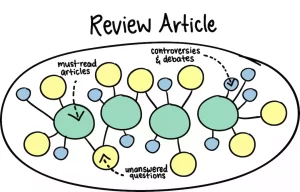Research Article and Review Article: Research articles are important for those who want to finish their doctoral degree. They can be published in journals of academics or they may just need them to support their thesis. Many people are unaware of the difference between review articles and research articles, and even some think they are identical. This article will highlight the differences between research articles and review articles.
A research article, as its name implies, is an overview of primary research. The author clearly states what he has done, studied something, found something, tested it, and then developed something. The research article summarizes all the work the author has done and presents the final results.
Definition of Research Article

Research articles are scholarly documents that present the results of research conducted by their authors. Researchers report their findings, methods and interpretations related to specific research questions or hypotheses. Research articles typically appear in academic journals after being subject to rigorous peer reviews; their validity and quality is verified via this process. They add significantly to knowledge by sharing new insight or discoveries across fields of study.
Definition of Review Article

Review articles (literature reviews) provide an in-depth assessment and evaluation of existing research in an area, by reviewing multiple published studies from multiple sources to synthesize current knowledge in that subject matter. They focus on trends, gaps, and controversies within literature while simultaneously giving readers a complete picture of its history, concepts methods findings related to this particular topic – helping readers stay abreast of the latest findings while consolidating knowledge for further explorations and providing invaluable insights for further studies.
Importance and purpose of both types of articles
- Research Article
- Knowledge Advancement: Research articles play an essential part in furthering and disseminating knowledge across numerous fields. With their inclusion as literature contributions, research articles present new findings, methods, and insights from research studies that foster greater knowledge development within particular disciplines or fields of study. These publications help create understanding within specific subject matters by expanding this body of information.
- Validating Research: Experts in the field evaluate a study’s results and methodology through an intensive peer-review process, giving scientific communities confidence that its research findings are valid and of quality. This ensures the validity and credibility of results to scientific communities worldwide.
- Dissemination: Research articles provide researchers a vehicle for communicating their findings to wider academic and scientific communities while disseminating them to scholars, practitioners, and students alike.
- Research: Research articles can serve as an excellent way to illuminate potential research avenues. By outlining gaps, limitations, or unanswered questions that need further examination, they allow researchers to expand upon current knowledge while exploring emerging research fields.
Review Articles are crucial components of academic publishing, providing valuable resources that highlight topics. Here is their significance in detail.
- Review Article
Review articles provide researchers and readers alike with a summary and synthesis of existing research in one field, helping readers better comprehend current knowledge, key concepts and debates within that discipline. By compiling and analyzing various studies into one comprehensive overview, review articles provide readers with a complete picture. They help identify trends, patterns, and inconsistencies within the literature as well as identify them quickly.
- Searching For Research Gaps – Review articles can often reveal areas that require further examination, as they serve to inspire further studies by reviewing existing literature, identifying knowledge gaps, and suggesting research directions.
- Review Articles Summarize Complex Topics – Review articles provide accessible, succinct information that simplifies complex topics for readers. They give readers an overview of a topic’s history while summarizing theories, methods and main findings; helping researchers, practitioners, students and others gain greater insights into its breadth and depth of content.
- Support of Evidence-based Practice, Review articles are fundamental in supporting evidence-based practices. By giving healthcare providers, policymakers, and practitioners access to all available evidence they are better equipped to make decisions based upon facts while creating guidelines or implementing evidence based interventions.
- Review articles are essential components of the academic world; they synthesize existing knowledge to support evidence-based practices while research articles provide new knowledge that enables growth, diffusion and application across different areas.
Research Article
Research articles are scholarly documents that detail the results of research conducted by their authors. A research article serves as the primary information source on methodology, results and interpretations related to one particular question or hypothesis in an academic journal publication; hence their significance as advances knowledge advancement across many fields.
Here are the essential characteristics and elements that comprise a research paper:
- Original Research, Articles that present original studies primarily concentrate on sharing new knowledge gleaned through them, so the emphasis here lies on the originality of investigation rather than summarising research already completed by others. Authors conduct studies either to answer a research question, solve an existing problem or test a hypothesis.
- Research articles usually follow a standard format consisting of five major sections – introduction, methodology, results, discussion, and conclusion – when reporting findings of research projects and their outcomes. Each of these subsections serves an essential function when conveying the findings of the study to readers.
- Introduction, Provides background information and establishes a research question or problem before outlining its goals or objectives for the study.
- Methodology, This section details the research design, sample population and any statistical analyses or techniques utilized during its conduct.
- Results, Summarizes findings of research as tables, graphs or descriptive text without offering interpretation or discussion of them.
- Conclusions/Discussion, Provides analysis and interpretation of findings related to the research question; compares results with similar studies; discusses limitations/consider future directions as appropriate; propose future directions as desired.
- the findings and their significance are briefly reviewed, along with any future recommendations or possible research efforts that might be helpful for moving forward with research studies.
- Before being published, research articles undergo a stringent peer-review process by experts in their fields to ascertain the validity, quality, and methodology of each research article presented for publication. This helps ensure accurate and reliable findings are published for public consumption.
- Citations and References – Research articles often feature citations that acknowledge previous work that has shaped their study, providing readers an easy way to discover similar studies, while verifying claims made within an article. These citations give readers access to additional research which might confirm claims in it.
- Contributing to Knowledge Research articles make significant strides toward furthering knowledge in their chosen field, adding insight, data, or methodologies not previously found within the existing literature. They offer researchers an avenue for sharing findings, initiating further investigation, and expanding upon other people’s work – all while building upon the prior efforts of others.
- Research articles are academic documents that outline the results of research studies. Peer-reviewed, they help advance knowledge in specific fields while simultaneously disseminating new findings, shaping research agendas, and encouraging intellectual debate among researchers and academics alike.
Review Article
- Review articles or literature reviews provide concise analysis and evaluation of current research in an academic field or discipline. As secondary information sources that synthesize published studies from multiple sources to give a holistic overview of a subject area’s knowledge base, literature reviews give researchers access to up-to-date and pertinent knowledge base information for an informed decision process.
Here are the main elements and characteristics of an effective review:
- Summary of Existing Research, Review papers provide an in-depth, condensed overview of research done on any given topic. They cover literature such as key concepts and theories as well as methodologies and findings; readers who want a broad grasp on current knowledge within an arena could gain from reading review papers.
- Review articles use an analytical process to select and include studies. Authors set criteria for inclusion such as publication dates, study designs, sample sizes and geographic locations of studies they choose for inclusion; all included studies will be relevant, reliable and representative of the subject under investigation.
- Review Article Format and Structure Review articles generally use a standard structure which comprises these components,
- Introduction, Provide background information, explain its purpose, outline its scope and objectives and present any pertinent details that are applicable.
- This review presents criteria for selecting studies for inclusion.
- Summary and Synthesis, This section presents an overview of key findings, methods and points presented within each study included herein. Depending upon how each author organizes his or her information, this summary/synthesis may either follow an alphabetic order or thematic organization scheme.
- Critical Evaluation provides an in-depth assessment of each study included in this compilation, detailing its strengths, weaknesses and limitations as well as any gaps or inconsistencies that need to be filled or areas for future investigation. Furthermore, it suggests future areas for exploration.
- Conclusions, In this section, key findings, their significance, and any future directions of research should be summarized and discussed. It may include potential new avenues of investigation as well.
- Evaluation and Analysis Review articles conduct in-depth critical evaluation of existing research critically, recognizing trends and patterns as well as any controversial aspects. They compare and contrast studies while outlining methodological weaknesses or strengths and may highlight any contradictory findings or knowledge gaps that need addressing.
- Secondary Sources, Review Articles are considered secondary sources, since their content draws heavily upon original research articles published as primary sources. Review articles provide readers with an analysis of multiple studies or interpretations rather than reporting novel research conducted by authors themselves.
- Contribution to knowledge, Review articles are essential tools in synthesizing and disseminating information; they serve as an indispensable way for researchers, students, and practitioners alike to stay up-to-date with research in their respective field.
Review articles provide researchers with a summary, evaluation and synthesis of existing research in any given field. They allow them to gain a more in-depth knowledge of its state as well as to identify gaps and gain an overall picture. Review articles also help disseminate existing knowledge while furthering studies within specific disciplines.
What is the Difference between a Research Article and Review Article?
Research articles and reviews articles both serve different functions and possess unique properties that set them apart. Here are a few key differences between review and research articles:
What are its purposes and objectives?
Research Articles: Research articles describe original research conducted by authors. Their aim is to present new knowledge, empirical data and interpretations gleaned from this investigation.
Review Articles: Review articles are meant to summarize and synthesize existing research on a specific subject area. They offer an overview of current knowledge, identify trends and evaluate existing studies.
Data and Methodology
Research Articles, These publications represent a result of conducting primary research – its implementation, design and analysis – with relevant details regarding methods employed, data collection procedures used and sample sizes included.
Review Articles Review articles do not collect primary data directly but rather aggregate findings from published studies that meet certain criteria and analyze them thoroughly before summarizing key findings gleaned from each.
Structure and Organization
Research Articles, When writing research articles, following a standard format is typically essential in providing an objective evaluation and presentation of research processes and outcomes. This structure typically features sections for introduction, methodology and results analysis discussion and conclusion allowing readers to easily follow along and evaluate each stage in the research journey.
Review Articles are flexible pieces, yet usually contain an introduction and selection criteria; an evaluation summary; findings summaries, evaluation of findings as well as conclusions; these components come together to form the essence of review articles, a comprehensive synthesis and evaluation of existing research.
Depth and Scope of Analysis and Extent of Coverage
Research Articles, Research articles tend to address specific research questions or hypotheses and include detailed accounts of their design, data analysis and interpretation.
Review Articles Review articles offer an overarching review of various studies, designed to give a broad perspective and identify any discrepancies or gaps within existing knowledge.
Writing Style and Tone
- Research Articles: Research articles typically adhere to formal writing styles. Their focus tends to center around specific aspects of research such as methods and results rather than providing extensive background details.
- Review Articles: Review article writers typically employ an explanatory or narrative writing style in their pieces to give background information, and contextual details and make complex concepts understandable to their readership.
Citing and Referencing Practices
- Research Articles: Research articles serve primarily as references and citations of studies which influenced their own research, or sources that are directly relevant to a specific project.
- Review Articles: Review articles are articles that gather together various studies related to their topic for examination and include extensive citations that support analysis and synthesis of the literature.
Research articles and review papers vary significantly in purpose, method, structure, level of analysis, style of writing and citations. Review papers synthesize existing research to report it while original research articles report original studies conducted within their fields of inquiry. Both types are equally essential parts of academic discourse for furthering knowledge creation, dissemination and advancement within each respective discipline.
Importance and Benefits of Research Articles and Review Articles
The Benefits of Research And review Aticle is given Bellow:
Importance and Benefits of Research Articles
- Knowledge advancement, Research articles play a vital role in furthering knowledge within specific fields. By adding new insights, methods, and interpretations to literature. Furthermore, their content often stems from original research conducted to gain greater insights into phenomena, theories or practical applications of study.
- Validating Research, Research papers undergo peer reviews that ensure their validity and quality, using this process of validation as an assessment of methodology, data interpretations and analyses that help increase the credibility of results. In essence, validation ensures that research articles offer reliable information for other researchers, scholars or practitioners alike.
- Researchers use research articles as an effective means of disseminating their findings to academic and scientific communities. By publishing their work, researchers can disseminate findings, methods and insights they’ve acquired – furthering collaboration, knowledge exchange and possible collaborative relationships.
- Research articles can act as catalysts to spark further inquiry, by outlining future avenues and pinpointing gaps in current knowledge or unanswered questions, suggesting areas requiring further exploration or outlining possible avenues of investigation requiring further exploration – encouraging more investigation while expanding fields. This stimulates new work while furthering science.
Importance and Benefits of Review Articles
- Review Articles to Summarize Research | Synthesize Knowledge Review articles provide an overview of existing research by synthesizing findings across studies to reveal patterns, trends and discrepancies that help researchers, scholars and practitioners gain an in-depth knowledge base about specific fields. They serve as useful guides that allow for comparative analyses between studies that span various topics as well as comprehensive understandings.
- Finding Research Gaps – Review articles are frequently utilized as an effective method for locating research gaps. By reviewing existing literature and looking for areas requiring further exploration or discrepancies between studies conducted elsewhere and those already underway, this allows researchers to quickly pinpoint areas requiring further examination or detect inconsistencies or contradictions within them, helping identify research gaps while creating questions to broaden knowledge bases and create research questions of their own.
- Review articles are essential tools in supporting evidence-based practices. By summarizing and assessing available evidence, review articles provide practitioners and policymakers an overview of best research studies available today. They serve to bridge the gap between academic studies and their practical application enabling informed decision-making across diverse fields.
- Keep Up With Developments in their Field, Review Articles are invaluable resources for scholars and researchers in staying current on developments within their fields of interest. By summarizing various studies quickly and efficiently, review articles provide readers with a quick way to digest an ever-expanding body of literature quickly. These pieces also prove essential tools when conducting in-depth studies about any particular topic.
Both research articles and review articles serve the academic and scientific communities well. Research articles contribute new knowledge while validating findings while review articles help identify research gaps while keeping researchers abreast of recent discoveries and informing practices based on evidence-based methodologies. Both types of articles help spread and apply this knowledge throughout various fields.
Conclusion
Research Papers as well as Review Articles are essential pillars of academic publishing, and each contributes in their own way to advance knowledge. By adhering to the best procedures and guidelines applicable to both kinds of papers, researchers can guarantee the quality and effectiveness of their research. As the field of academics continues to change, embracing these methods will help to foster excellence in publishing scholarly work and will help grow the knowledge base of all.
https://www.youtube.com/watch?v=uEsAKqXSfbY

